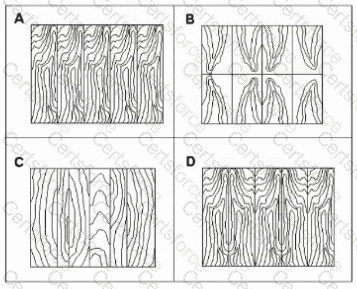Understanding Slip Matching in Wood Veneer
When wood veneer is sliced from a log, each sheet (or "leaf") has a repeating grain pattern. How those sheets are arranged side-by-side on a panel is called the matching method.
Slip Matching:
Consecutive leaves are laid side-by-side without flipping or reversing them.
This creates a repeating grain pattern that flows consistently across the panel.
The result is a uniform, continuous grain with no "mirror image" effect — the cathedrals and figure in the grain run in the same direction from sheet to sheet.
Slip matching often produces a striped effect if the grain is straight, or a flowing, consistent repeat if the grain is more figured.
Identifying Slip Matching in the Exhibit:
Option A shows consecutive veneer leaves with the grain pattern running in the same orientation across the panel — no mirroring, only repetition. This is classic slip match.
Option B shows book matching — where every other leaf is flipped horizontally to create a mirrored grain pattern.
Option C appears to be random matching — leaves are placed without grain sequence alignment.
Option D shows reverse slip matching — similar to slip match but alternating leaves are reversed end-to-end.
NCARB ARE 5.0 PDD Study Guide References:
Content Area: Integration of Materials & Finishes — Millwork and Casework Veneer Matching Methods
Sources:
Architectural Woodwork Standards (AWS) — Section on Veneer Matching
Architectural Graphic Standards — Finish Carpentry and Veneer Matching
Building Construction Illustrated (Ching) — Interior Finish Carpentry
Key Point:
Slip matching keeps all veneer leaves in the same orientation, producing a consistent flow of the grain without the mirrored effect seen in book matching.

Submit